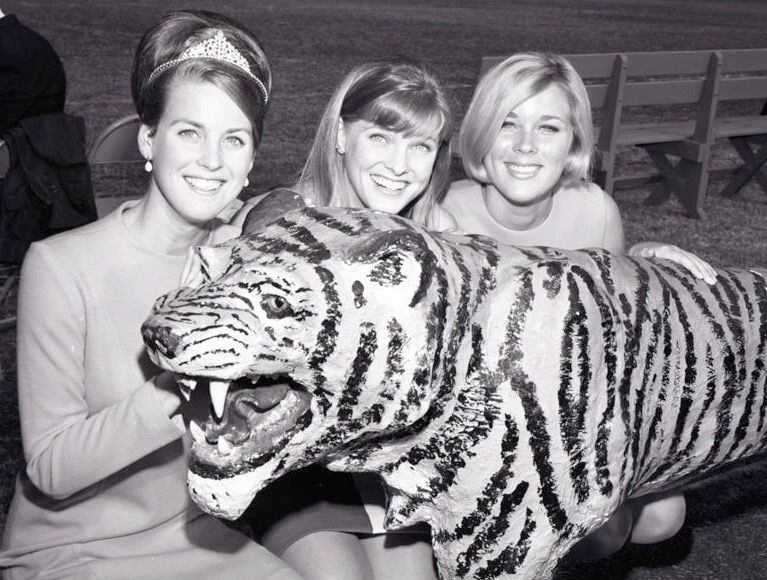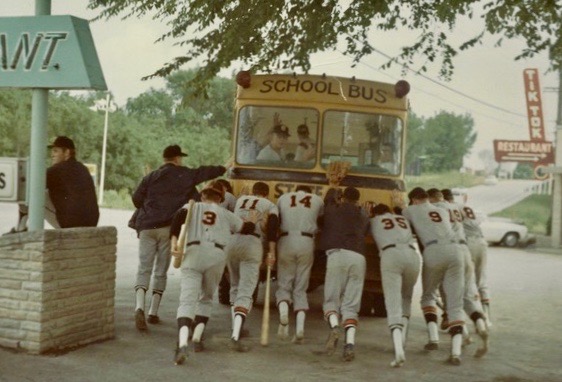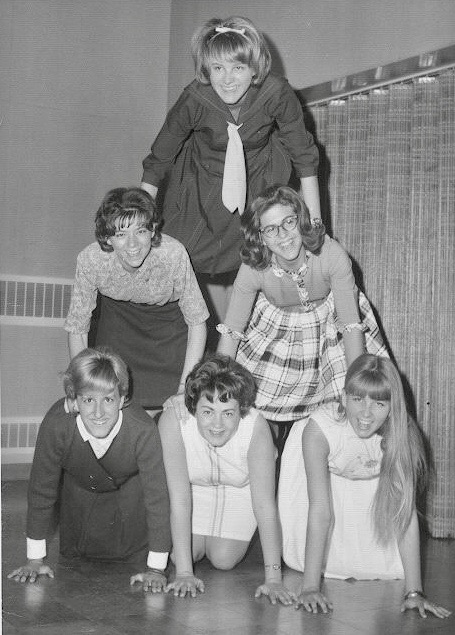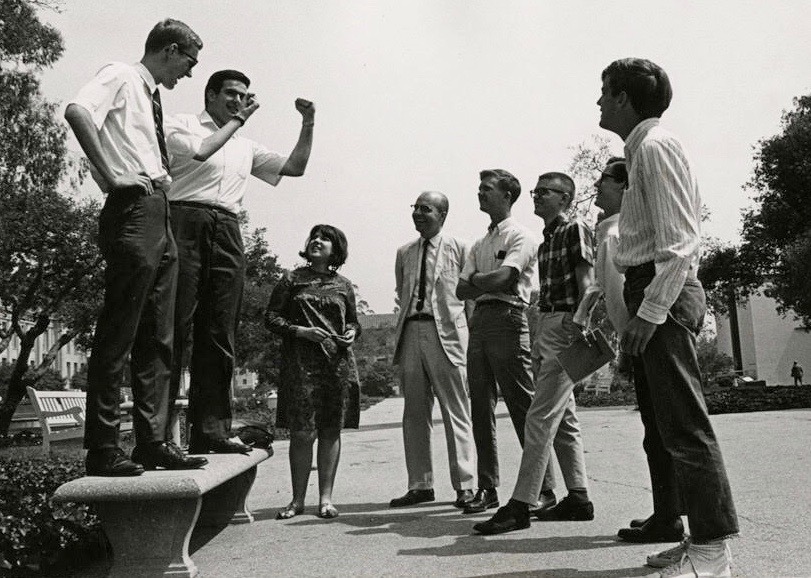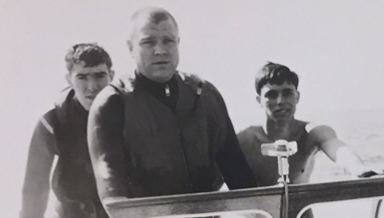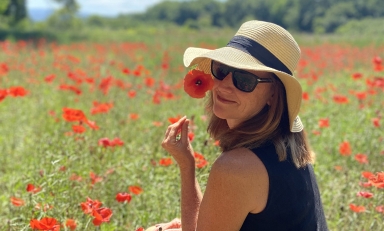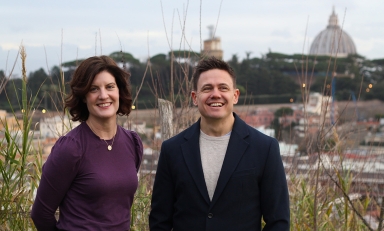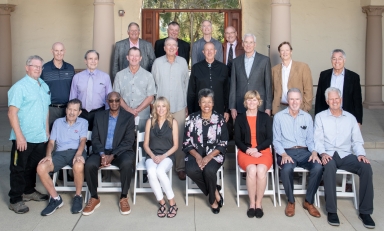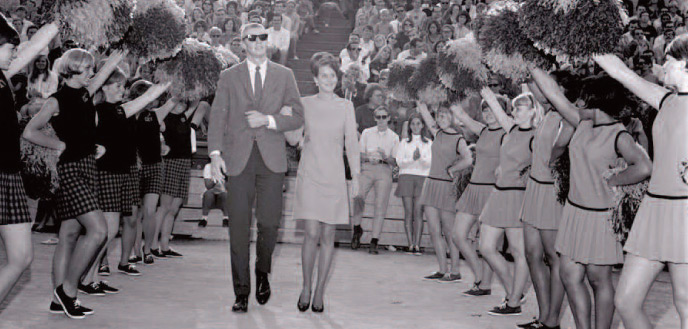
As their golden anniversary fast approaches, members of the Class of 1968 refllect on four years that changed the world and shaped their Oxy experience
As a high school junior from Fullerton, Meredith Mason Garcia ’68 “fell in love with Oxy in the spring of 1963, on a campus visitation day,” she recalls. “I loved the campus, I loved the atmosphere, I loved the people I met, and most of all, I loved the idea of a liberal [arts] education. The two-year History of Civilization course intrigued me. The three-term academic calendar also attracted me—the idea of being able to focus on three courses at a time during each term.” Garcia applied to Oxy as an early decision candidate. “I was over the moon with excitement when I got my letter of acceptance,” she says.
When Garcia and her 395 classmates arrived in September 1964, they were extolled in The Occidental by admission director William Callison as a group of students “selected with an emphasis on distinctive personal characteristics” over traditional academic credentials. “It would be misleading to convey the impression that statistical data was not important,” he wrote, “but in most cases interesting background, or unusually developed talent, a flair for verbal or written persuasion, demonstrated ability in the arts—a multitude of non-statistical factors were the decisive ones.”Callison’s forward-thinking admission standards produced an extraordinary group of young people—234 men and 162 women—who transitioned toward adulthood during a period of powerful change for the College and the country. And if class notes are any measure of engagement (turn to page 47 of the Spring magazine if you doubt us), they remain committed to Oxy, and each other, on the cusp of their 50th reunion.
What can we say about the Class of ’68? Roughly seven out of 10 students hailed from California, while seven students (from Canada, Chile, Holland, Hong Kong, and Jamaica) brought an international flavor to the class.
Although there is no hard data on ethnicity, the names and faces in the 1964 student handbook suggest that less than 10 percent of the class was non-white (a number that Callison was already working to address).
What do classmates say about themselves, their Oxy experiences, and their life outcomes half a century after leaving Eagle Rock? Plenty. In a survey sent by Occidental magazine in mid-February, members of the Class of ’68 were asked to reflect upon their school days with the benefit of hindsight.
What brought them to Occidental? Survey respondents consistently pointed to the beauty of the campus, the appeal of a small college, and the reputation for academic excellence. Almost one out of three respondents had family or friends who attended the College. Others cited financial aid packages or specific academic offerings, notably diplomacy and world affairs, education, English, philosophy, and music. Patricia Varney Hardy, who arrived as a transfer student in 1966 and sang in the Glee Club, offered the simplest and most pointed reason for choosing Oxy: Glee Club director “Dr. Howard Swan.”
Sports drew a few students. Norris “Nob” Scott was recruited by baseball and basketball coach Grant Dunlap ’46, transfer Rob Russell “wanted to run” on Oxy’s standout track team, and Barry Sears candidly admits that Oxy was “one of the few schools where I could continue playing basketball with my limited physical skill set.”Others simply listened to their parents. “My mom chose Oxy for me and I managed to get a music scholarship,” writes Sue Ashley Meyer. “We would not have been able to afford Oxy otherwise.”
“It was the only college that my father allowed me to apply to,” recalls Martha Carriger Giffen, a graduate of Eagle Rock High School. Her dad also insisted that she live at home throughout college: “He was afraid I might learn something or make friends that he didn’t approve of.” (She later married George Giffen ’60, whom she met after graduation.)
We asked alumni to list up to three of their favorite classes and favorite professors. The favorite class by far? History of Civilization, the two-year team-taught survey course taken by all freshmen and sophomores, appeared on 43 out of 77 questionnaires—a whopping 56 percent. (Try getting 56 percent of people to agree on anything.)
Psychology classes were listed by 20 alumni, with Abnormal Psychology appearing on eight questionnaires and Social Psychology on five. No other course received more than three mentions—a testimony, perhaps, to the eclectic interests of the Class of ’68.
Considering the popularity of History of Civ, it’s no surprise that Robert Winter—Arthur G. Coons Professor in the History of Ideas Emeritus and chair of the Civ program—was the most popular professor, included on 24 questionnaires. Psychology professor David Cole M’47 was a strong second, listed on 13 questionnaires, followed by the aforementioned Howard Swan with 10. Another dozen professors were listed by three or more alumni, and it’s safe to say that almost every professor at Oxy during the period was at least one student’s favorite. (“Would be easier to list those who weren’t my favorites,” writes Kathy Wray Williams.)
About 30 percent of respondents played on a College sports team, and three out of four engaged in other extracurricular activities. Almost half of those belonged to fraternities or sororities. College Choir and other musical activities were especially popular, but as a whole, the Class of ’68 seems to have taken advantage of almost every activity available.
One of the most popular activities outside the classroom was looking for and often finding romance. Almost one out of three survey respondents met their future spouses at Oxy. Three others married Oxy alums whom they met after graduating. A few pointed out that their first marriage didn’t last, but many are still happily married some 50 years later.
We asked the class how Oxy changed during the years they were there. Their replies were remarkably consistent, but Alan Takeda sums it up nicely: “Oxy changed as the times changed,” he writes. “As a freshman, coeds had a curfew, Vietnam was a minor issue, and my class had about two dozen minorities, doubling the number at the school. Patriotism was high, and I remember that I would die for my country. Civil rights was a dilemma for many.”
The turning point seems to have been 1966, when the Class of ’68 ended their sophomore year in one world and began their junior year in another.
“Change came more slowly at Oxy than at more liberal places such as Berkeley and Columbia,” writes Ann La Rue Matlow. “Before our junior year it was more traditional and clean-cut, the way schools might have been in the ’50s.” Marcia Bridge Cooke echoes the same idea: “The cultural life changed from a vibe of the ’50s to that of the ’70s in the space of two years: 1966 to 1968.”
Much of this reflected change in the world around them. “It was the ’60s. The whole world changed,” writes Mary Lou Kurtz. “We lost our insular focus,” remembers Judy Clark Everitt. “We grew outside ourselves and became citizens of the country while the country itself grew up.” There was also a shift in student attitudes as the older classes graduated. “In 1966, the culture of the students changed,” writes Sue Budd Chaplin. Incoming freshmen “resisted the traditional, protested inequalities, and were far more socially aware and active than I was.”
“By the time we were seniors, a number of juniors, sophomores, and freshmen became politically radicalized,” Phil Nichols recalls. “Also, drugs rolled heavily starting in the fall of 1966.”
Although marijuana was the drug of choice, LSD— which was legal in California until October 1966—was a hot topic of discussion and experimentation. In his 2010 memoir Two Years at Occidental in the Late Sixties, Charles Rouse, an Air Force veteran who transferred to Oxy as a junior, recounted a bad drug experience with recurring flashbacks that began in January 1967 when, unbeknownst to him, a fellow student “dosed” him with a drug that was probably LSD. “Something swept through me like an electric wind, going upward,” he wrote. “Every time this happened, I became higher, more intoxicated. I definitely felt high and I definitely felt afraid.”
In October 1967, the College launched a series of discussions on drugs, kicked off by a lecture on LSD by psychiatrist and former Oxy counselor Carl Faber ’57. Weekly follow-up sessions were held in the dorms.
The big flashpoint on campus junior year was the lockout policy for women’s dorms, which required women to be back in their residence halls by curfew—midnight Sunday through Thursday, 2 a.m. on weekends. “Women were protected and rule-bound early in my college career—skirts required in class and the library, restrictive hours in the dorm, etc.,” Christine Shannon Panero writes. “By my senior year, all that was gone.”
As a freshman, Nora Larimer Davidson recalls “taking doors off girl’s dorms to protest the early [curfew] hours we had.” The protest escalated in February 1967, when almost 400 students, including 177 women who walked out of their dorms, gathered for a rainy 2 a.m. protest at the intersection of Bird and Jacaranda (now Gilman) roads, with speakers using a platform fashioned from a Quad bench. The curfew was lifted for all students except freshmen in September 1967—a year after the opening of Norris Hall, Oxy’s first coed dormitory.When she arrived at Oxy in 1964, “the freshman ‘girls’ wore white gloves and pillbox hats on Sunday and to sorority open houses,” Sarah Jean Walker Shaw writes. “By the time I graduated, the Oxy ‘women’ were protesting lockout at the dorms and the requirement to wear skirts and dresses to meals.”
Adds Toni Bell Sullivan: “When I describe my college years to my children and grandchildren, I mention that I went from wearing gloves to the Freshman Tea with the College president to smelling the scent of marijuana wafting out of the restroom in Erdman Hall.”
Although the lockout battle was primarily over the idea of being treated as adults without the College acting in loco parentis, it occurred within the context of the sexual revolution. In November 1965, psychology professor Luther Jennings and speech and drama professor Lee Roloff conducted a public discussion of the “Playboy Philosophy” in which they endorsed the ideas of premarital sex and greater access to birth control. (Roloff called Playboy “superficial titillation” but agreed with the fundamental ideas.) The following Sunday, Chaplain John Smylie delivered a sermon in Herrick Chapel titled “Playboy Philosophy—Another View.”
The battle for women’s rights was followed by a rising concern with inclusion of students of color. “Oxy started to realize its own institutional obligations to deal with non-white ethnic relations and education,” Joseph Duff recalls. The Black Student Caucus was formed in November 1967, and three months later Oxy sponsored its first Black Arts Week, featuring African-American music, dance, poetry, theater, film, lectures, and food. There was also a growing Brown Power movement by Latino students.
“My freshman class, and those after us, included larger groups of black and Latino kids who were part of a big effort to diversify the student body,” writes Martha Carriger Giffen. Much of that effort came directly from the students themselves. After the Class of ’69 entered in fall 1965, The Occidental reported: “Occidental now boasts the strongest minority group representation in its history” due to two years of work by students on the Minority Admissions Committee, who reached out directly to promising high school juniors and seniors.
Serious anti-war protests did not begin at Oxy until the fall of 1967, the Class of ’68’s senior year. Despite the growing ferment on campus, relatively few alumni—16 out of the 77 who responded—considered themselves politically active at Oxy, while another dozen or so cited peripheral experiences or support for those who did take action. Most indicated that they were not active at all. More than half of the respondents said they had become more liberal over the years since graduation.
Among that number is Phil Jones, who describes 1964-68 as “a period of rapid change in the nation and at Oxy. In addition to drugs and pop culture, there was much going on in the world to be gravely concerned about, and as a generation my classmates were definitely questioning the values of our parents and political leaders.”Marilyn Soash Stivers Durazzo—one of a small number of respondents who said they became more conservative after Oxy—writes that her favorite Oxy memory was “being a conservative on campus during the tumultuous ’60s.” It was, indeed, an interesting time for students on the right. When the Class of 1968 entered in the fall of 1964, a campus poll found that 40 percent of Oxy students were Republicans, 28 percent considered themselves independent, and only 28 percent identified as Democrats. Even so, President Johnson far outpolled Sen. Barry Goldwater, who received his strongest support from the incoming freshmen.
In February 1966, as campus politics swung toward the left, the Occidental Young Republicans, who “went to bat for Barry” in 1964, began a movement to broaden their membership base and distance themselves from the increasingly right-wing California Young Republicans. A year later they cut ties completely with the state organization—denounced by Oxy YR president Tom Robertson as “a right-wing neo-fascist sect”—and joined the more moderate California College Republicans. In the fall of 1967, a new organization called the Occidental College Conservative Union offered a forum for ideological conservatism in the spirit of the National Review.
Thak Chaloemtiarana, a graduate student from Thailand who received his master’s in diplomacy and world affairs in 1968, may have had the most unique political awakening at Oxy: “I remember being asked to give a talk in Thorne Hall [in November 1967] about Thailand’s position in the Vietnam War. My talk was toeing the official Thai nationalist discourse of anti-French imperialism and pro-U.S. Cold War policies. It did not take long for me and my fellow Thai grad students to question our beliefs about the war when we met Oxy students who were protesting the draft and the war. We became radicalized by the anti-war experience and many of us eventually became active in opposing the Thai dictatorial government, which supported the U.S. war in Vietnam.”
A number of alums who said they became more liberal noted that their activism increased after graduation, as they entered a world that was changing faster outside of campus. “Of all years to be graduating, 1968 is still infamous today for the degree of wrenching trauma in the adult world we were entering,” writes Carolyn Taylor.
In fact, the trauma began before graduation. The assassination of Martin Luther King Jr. on April 4, 1968, felt personal at Oxy, where King had spoken just one year earlier. The fatal shooting of Sen. Robert Kennedy in Los Angeles on June 5, the day after finals ended, felt even closer. Taylor remembers watching the California primary results live on TV in the Gamma sorority house, “resolving that I was going to devote myself to working for Bobby Kennedy as I listened to him give his acceptance speech, only to have the third awful trauma of our youth take him away before my eyes minutes later. It was a moment that changed me forever.
“I’ll never forget the next day, going to my job as secretary in the history department,” she continues. Professor Norm Cohen was as devastated as she was, saw that trying to get work done was futile, and invited her to join him on a “mostly silent afternoon walk” in the after-finals quiet on campus.
For the young men and the young women who cared about them, another wrenching trauma was the draft and the potential to be sent to Vietnam. The 2-S student deferment was still available in 1968 (the lottery was instituted in 1969), so for many men, graduation was a double-edged sword, a milestone of academic achievement and the beginning of full exposure to the draft.
Don Fallick was drafted in November 1968, “despite three presidential appeals,” he notes. “I was teaching English in a Central L.A. junior high school, and had one class composed entirely of juvenile felons on early release from prison. On the same day that he turned down my last appeal, President Johnson made a televised speech urging the college students of America to become teachers and teach in the ghettos of American cities.”
Phil Jones was drafted into the Army in 1969, while attending grad school at Cal State L.A. “My music training at Oxy provided the opportunity to serve as a chaplain’s assistant at the U.S. Army Chaplain School at Fort Hamilton in Brooklyn and tour manager for the 7th Army Soldiers Chorus in Heidelberg, Germany,” he writes.
Martin Maner left Oxy “with a four-year free ride to the Ph.D., thanks to the University of Virginia and the Danforth Association,” he writes. After he was drafted—and despite his opposition to the war—Maner took training and ended up at a Green Beret camp on the demilitarized zone. “I survived, returned, and got reinstated in my fellowship.”
Joseph Duff’s Air Force ROTC experience at Oxy permitted him to serve in the military “on my own terms, as an Air Force judge advocate,” he writes. “I completed my service obligation and moved on to a fruitful and meaningful career.”
Some grads avoided the draft through alternative service—or a lucky break. John Goodwin joined the Peace Corps. Jim Ellis, a conscientious objector, served two years on the staff of the Yale Psychiatric Institute. Alan Takeda was inducted into the Army, had his draft rescinded for a conscientious objector hearing, and lost his case. During appeal, “My dilemma was whether to go to Canada or prison,” he recalls. “A medical technicality got me reclassified 4F.”
Frederick “Fritz” Maerkle planned his post-Oxy activities with the expectation that he would be drafted. “As it turns out, the U.S. Department of State offered me a position as a Foreign Service officer and the draft board considered that I was ‘serving my country’ by working in an American embassy overseas.”
We asked respondents how their Oxy education prepared them for their career path. Maerkle replies: “The diplomacy and world affairs program gave me the breadth of knowledge to pass the Foreign Service exam and an in-depth understanding of American foreign policy.” He retired in 2011 after a 42-year career as a Foreign Service officer. Mary Lou Kurtz worked for TWA for 14 years “and frequently used my French with foreign passengers.”
A number of teachers reported a direct connection from Oxy to the classroom. “I felt very prepared by the time I obtained my first teaching position,” writes Sarah Schildmeyer, reflecting a widely held respect for the education department and professor Jo Stanchfield.
“Since I was a music major, my Oxy experience prepared me for my initial career as a college music teacher,” Phil Jones notes. “The strong liberal arts curriculum at Oxy further prepared me for my second career as a government arts administrator.”
Many who went on to graduate or professional school also saw a direct connection. “The science courses at Oxy were so outstanding that I aced the first two years of medical school,” Steve Johnson writes. Fellow doctor Tom Hartman notes that Oxy “prepared me very well with not only a solid foundation in the biological sciences but also a knowledge of humanities.”
Attorney Jim Ellis remembers: “The academic rigor and learning process helped in obtaining both my MBA and J.D. Gaining a world view of events and how they interrelate through History of Western Civilization was and is instrumental in both my business and personal life.”
For most alumni, the biggest gift of an Oxy education was a broader preparation for life. “A career was of minor importance,” Alan Takeda writes. “Hard work, love of learning, and the high standard of peers all raised the bar of my expectations.”
Judy Greene’s takeaway from Oxy was “a much-appreciated way of thinking, looking beyond the surface of things—a broad liberal arts education that has helped me be interested in and tolerant of various viewpoints and values, and interested in almost everything.”
“My experience at Oxy taught me to think critically, and appreciate those with whom I did not agree,” writes Brenda Shockley, who was named deputy mayor for economic opportunity by Los Angeles Mayor Eric Garcetti in May 2016 after more than 24 years as president of Community Build.
“I went to Oxy to study chemistry, because I couldn’t write,” notes Barry Sears, a former research scientist at the Boston University School of Medicine and MIT and creator of The Zone diet. “Now, 16 books later, that’s all I do. Sometimes be careful of what you wish for.”
“My psychology class learnings often came to mind while working in human resources and then managing my own businesses,” writes Jeannine Florance. “Many of my classes taught me to ask questions and not take information or opinions at face value.”
While Brad Santos’ career path went “in a completely different direction” from what he’d hoped while at Oxy, “The greater takeaway,” he believes, “was a broader appreciation of all the other disciplines to which I was exposed as a diplomacy and world affairs major. It’s made me a much less boring person!”
About 80 percent of all survey respondents said they were still in touch with classmates, ranging literally from 1 to 100. Some stay in touch through Facebook or Christmas cards, but others manage to get together in person.
Steve Johnson and Alan Nishimura play golf together frequently, “and annually try unsuccessfully to win Alan’s golf club’s invitational tournament,” Johnson writes. Sarah Jean Walker Shaw’s sophomore roommate, Ginger Mason Vaughan, became a professor and Shakespeare scholar at Clark University in Worcester, Mass., “just 45 minutes away from my home in Providence, R.I.,” Shaw writes. “We’re having supper together next week.”
Brad Santos has his eye on the bigger picture: He gets together with “about six or seven classmates every year or so, four or five every few weeks, and every fifth year at the class reunion I reconnect with many more.”
This June’s reunion—which includes the group’s induction into the Fifty Year Club—promises to be especially momentous. Take it from Santos: There are plenty of reconnections to be made.
Paul Robert Walker ’75 is a class secretary as well as an author and historian. He wishes his own class was half as engaged as the Class of ’68.

